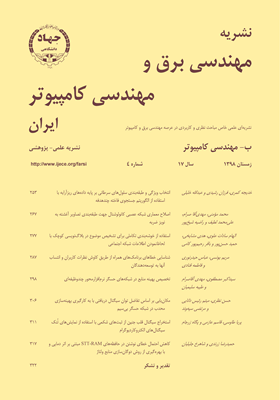کاهش احتمال خطای نوشتن در حافظههای STT-RAM مبتنی بر اثر دمایی و با بهرهگیری از روش دوگانسازی منابع ولتاژ
محورهای موضوعی : مهندسی برق و کامپیوترحمیدرضا زرندی 1 * , شاهرخ جلیلیان 2
1 - دانشگاه صنعتی امیرکبیر
2 - پژوهشگاه فضایی ایران
کلید واژه: حافظه STT-RAMقابلیت اطمیناننوسانات فرایند ساختخطای نوشتنسربار توان,
چکیده مقاله :
یکی از مهمترین مشکلات حافظههای STT-RAM امکان بروز خطا در این حافظهها است. از عوامل اصلی رخداد خطا در این حافظهها میتوان به نوسانات فرایند ساخت، نوسانات دمایی و وابستگی رخداد خطا به توزیع دادهای اشاره کرد و بنابراین احتمال رخداد خطا با توجه به داده موجود در هر سلول با سلول دیگر متفاوت خواهد بود. روشهای ارائهشده موجود عموماً بدون در نظر گرفتن رفتار حافظه در شرایط فیزیکی مختلف، اقدام به حل مشکلات حافظهها کردهاند که در نتیجه با سربار زیادی در توان و مساحت همراه هستند. بنابراین نیاز به ارائه روشی احساس میشود که در سطوح پایینتر، احتمال رخداد خطا را در هنگام عمل نوشتن کاهش دهد، با در نظر گرفتن این امر که سربار توان غیر قابل قبولی ایجاد نکند. به منظور کاهش رخداد خطای نوشتن و همچنین پیشگیری از سربار توان زیاد، پیشنهادی ارائه شده که با توجه به داده، مسیر جداگانهای برای نوشتن در نظر خواهد گرفت. هر کدام از مسیرها مشخصهای مطابق با داده خواهند داشت که در نهایت منجر به کاهش حداکثری خطای نوشتن میشود. در این راستا از مشخصه دمایی سلول برای کاهش زمان عملیات نوشتن بهره گرفته خواهد شد. شبیهسازیها نشان میدهد که اعمال این روش منجر به کاهش 38/11% زمان نوشتن در سلول حافظه شده که این دستاورد بدون سربار مساحت و یا توان نسبت به روشهای موجود حاصل شده است.
Write Error (WER) is one of the most drawbacks of STT-MRAM based memories. This problem usually occurred because of thermal instability and process variation. Although some methods have been proposed for WER reduction, they often did not consider the thermal effect of MTJ and had significant overhead. Therefore, proposing a new method in a lower layer of abstraction with the minimum penalty is essential. In this regard, a write driver core has been proposed, which uses two distinct ways according to the state of writing data based on the thermal feature of MTJ cell and by Dual-Vdd method. Simulation results show 11.38% write latency reduction without area and power penalty.

